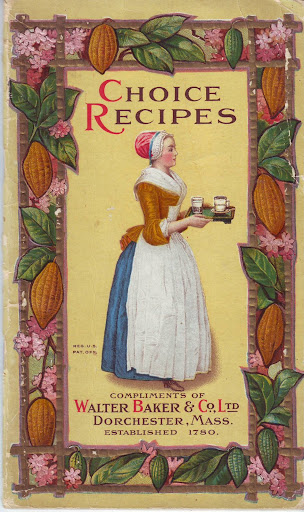Today we enjoy a real treat!
Scavanging through a yard sale I found this vintage
recipe book published by the food company Walter
Baker & Co. From this book we learn quite a few
fascinating facts besides learning how to make
"Wellesley Marshmallow Fudge" or "Baker's
Chocolate Divinity." Among other things, I have
learned that Walter Baker & Co. was a giant operation
with the company mills occupying 14 acres of space.
I have also learned that a guy named Baron von
Liebig was "one of the best-known writers on
dietetics" back at the turn of the century. The names
of the people providing the recipes are Miss Maria
Parloa, Miss Fannie Merritt Farmer, Miss Elizabeth
Kevill Burr, and Miss Janet McKenzie Hill. All of
their recipes are really for desserts involving chocolate
in some form or another. No biographical or
professional information is given about the writers.
But we sure find lots of information about the
girl pictured on the book's cover.
The Viennese girl holding a tray on the book's front
and back cover is the subject of a lengthy discussion.
According to the book, this picture was the company's
logo and she was "known all over the world as 'La Belle
Chocolatiere,' the trade-mark that distinguishes the
Cocoa and Chocolate preparations made by Walter
Baker & Co. Ltd." We learn that the company got this
image from a famous painting which "was the master-
piece of Jean-Etianne Liotard, a noted Swiss painter
who was born in 1702 and died in 1790." The next
line acquires some tragic connotations because it
tells us that this famous painting was on display in the
city of Dresden (Germany). Well, we all know what
happened to Dresden during WWII. Dresden was
that city that Americans decided "to destroy in order
to save it." The book (written in 1914) mentions that
the painting "is one of the chief attractions in the
Dresden Gallery, being better known and more sought
after than any other work of art in that collection."

Apparently the crowds of art lovers visiting the Dresden
Gallery were drawn to this girl carrying a tray with a
couple of drinks. The book claims that "there is a romance
connected with the charming Viennese girl who served as
the model." Then the book goes on to reveal some new
information that had been uncovered by a newspaper.
We are told that the girl's name is Anna Baltauf. She was
the daughter of Melchior Baltauf. He was a knight and he
was residing in Vienna at the time when the artist came
to the city to make some portraits of the members of the
Austrian court. The newspaper reporters were not able
to determine whether Miss Anna Baltauf was just posing
as a servant or she was actually a "chocolate bearer." In
any case that is irrelevant. What really matters is what
happened after the painting was finished. A certain Mr.
Dietrichstein, who happened to be an Austrian Prince, saw
the portrait of Anna Baltauf and fell in love with her.
He pursued her and married her. The book adds that
"the marriage caused a great deal of talk in Austrian
society at the time" because the daughter of a knight "was
not consider a good match for a member of the court." But
wait. There is more. "It is said," the book continues, "that
on the wedding day Anna invited the chocolate bearers with
whom she had worked or played, and in 'sportive joy at her
own elevation' offered her hand to them saying , 'Behold!
Now that I am a princess you may kiss my hand."
The painting was done about 1760. Anna was about twenty
years of age at that time. She lived until 1825.
My question today is: What happened to this painting
when the city of Dresden was destroyed? Does anybody know?
We also welcome any information available out there regarding
the authors of the recipes.
Germanicus

















